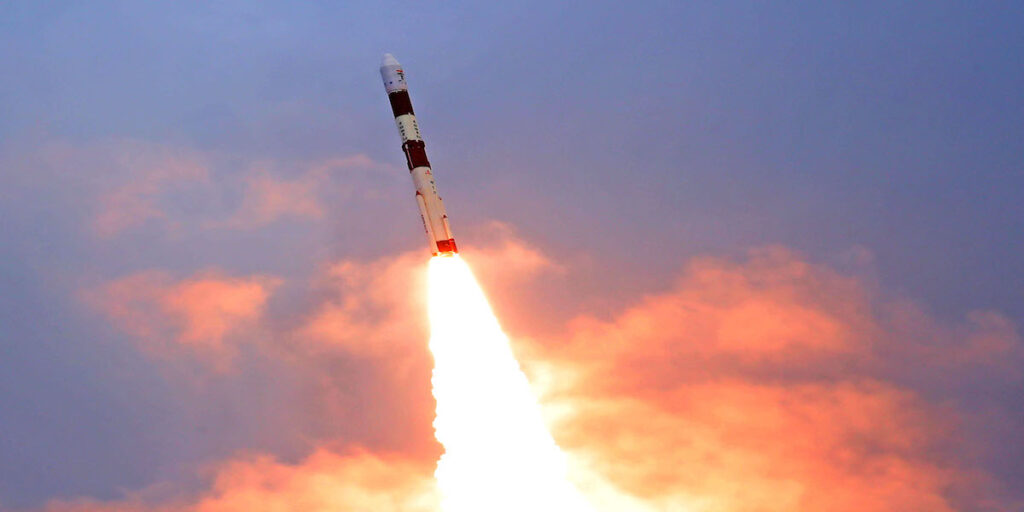India on the path of becoming a major Space Power

India’s Polar Satellite Launch Vehicle, in its fifty first(51st) flight (PSLV-C49), on November 7, successfully launched 7 EOS-01 along with nine international customer satellites from the First Launch Pad of Satish Dhawan Space Centre (SDSC) SHAR, Sriharikota in Andhra Pradesh.
PSLV-C49 lifted-off at 1511 Hrs (IST), after a delay of nine minutes because of inclement weather conditions observed during countdown.
After 15 minutes and 20 seconds, EOS-01 was successfully injected into its orbit.
Subsequently, nine commercial satellites were injected into their intended orbits.
After separation, the two solar arrays of EOS-01 were deployed automatically and the ISRO Telemetry Tracking and Command Network at Bengaluru assumed control of the satellite. In the coming days, the satellite will be brought to its final operational configuration.
“PSLV-C49 successfully placed all ten satellites precisely into their orbit” Chairman, ISRO, Dr. K. Sivan declared. He congratulated both the launch vehicle and satellite teams for rising to the occasion amidst the Covid-19 pandemic restrictions.
The nine customer satellites that were launched were are from Lithuania (1), Luxembourg (4) and USA(4). These were launched under a commercial arrangement with NewSpace India Limited (NSIL).
PSLV-C49 is the 2nd flight of PSLV in ‘DL’ configuration (with 2 solid strap-on motors). Besides being the 51st launch of PSLV, today’s launch was also the 76th launch vehicle mission from SDSC SHAR, Sriharikota.
EOS-01 is an earth observation satellite, intended for applications in agriculture, forestry and disaster management support.
This is ISRO’s first mission since the launch of RISAT-2BR1, another earth observation satellite similar to EOS-01, on December 11 last year. After that, ISRO had also sent communication satellite GSAT-30 in space in January this year, but that was done using an Ariane rocket launched from French Guiana. Thereafter, ISRO’s launch schedule was entirely derailed by the coronavirus epidemic.
ISRO had planned more than 20 satellite launches in the fiscal year 2020-21, including high profile missions like Aditya L1, the first exploratory mission to Sun, and unmanned Gaganyaan, the precursor to India’s first manned space flight. Half of the planned launches were those of earth observation satellites like the one which were sent yesterday.
According to Indian Express, EOS-01 is nothing but another Radar Imaging Satellite (RISAT) that will work together with RISAT-2B and RISAT-2BR1 launched last year. EOS-01 was initially named RISAT-2BR2, and was supposed to be the third of the three-spacecraft constellation aimed at providing all-weather round-the-clock service for high-resolution images.
The paper says that with EOS-01, ISRO is moving to a new naming system for its earth observation satellites which till now have been named thematically, according to the purpose they are meant for. For example, the Cartosat series of satellites were meant to provide data for land topography and mapping, while the Oceansat satellites were meant for observations over sea. Some INSAT-series, Resourcesat series, GISAT, Scatsat, and some more are all earth observation satellites, named differently for the specific jobs they are assigned to do, or the different instruments that they use to do their jobs.
Land and forest mapping and monitoring, mapping of resources like water or minerals or fishes, weather and climate observations, soil assessment, geospatial contour mapping are all done through earth-observation satellites.
In recent years India has done well to emerge as one of the major space powers of the world. The country does not wish to be eclipsed by China as Asia’s preeminent space-faring nation.
India realises it well that in order to be recognised as a major player on the world stage, it has to have a vigorous space programme. The country has been developing a high-tech sector for the past several years as a means of jump-starting its economy.
The ISRO has announced that it would like to build its own space station sometime in the 2020s. It will be a relatively small module, about 20 metric tons, and it would allow Indian astronauts to remain in Earth orbit for up to 20 days while performing experiments. ISRO plans to deploy the Indian space station about five to seven years after the first flight of the Gaganyaan, a crewed orbital spacecraft being developed by the ISRO.


